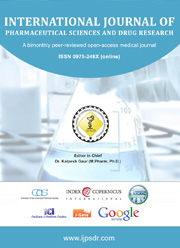1,2,3-TRIAZOLE CARBOXAMIDE DERIVATIVES AS NOVEL PROSPECTIVE ANTICANCER AGENTS: SYNTHESIS, CHARACTERIZATION AND IN-SILICO STUDIES
DOI:
https://doi.org/10.25004/IJPSDR.2024.160211Keywords:
1,2,3-triazole, Anticancer, MTT assay, EGFR, CDK-4.Abstract
The ongoing and persistent endeavour to discover effective new anticancer medications remains a steadfast objective. Presently, the focus of this research lies in exploring novel substituted derivatives of 1,2,3-triazole carboxamide. A set of novel derivatives of 1,2,3-triazole carboxamide(5a-5n) were successfully synthesized with yields ranging from satisfactory to excellent. These compounds underwent characterization using various analytical methods, such as 1H NMR, 13C NMR, and mass spectrometry. Their cytotoxic potential against four cancer cell lines—HeLa, PANC-1, HCT-116, and A-549—was evaluated in vitro. Notably, compounds 5j, 5i, 5m, and 5f displayed significant anticancer activity. Molecular docking experiments were conducted on the synthesized compounds, revealing strong binding interactions with the active sites of EGFR and CDK4-Cyclin D3. However, out of all the derivatives tested, namely 5i, 5j, 5g, 5f, and 5h, it was observed that these compounds displayed a favourable binding affinity towards both the EGFR and the CDK4-Cyclin D3 active site. The results of the study suggest that the synthesised compounds have potential as agents for cancer therapy. Furthermore, further alterations to the structure of triazole-carboxamide derivatives could lead to the development of effective anticancer drugs.
Downloads
References
Mithoowani H, Febbraro M. Non-Small-Cell Lung Cancer in 2022: A Review for General Practitioners in Oncology. Current Oncology. 2022 Mar 9;29(3):1828–39.
Anand U, Dey A, Chandel AKS, Sanyal R, Mishra A, Pandey DK, et al. Cancer chemotherapy and beyond: Current status, drug candidates, associated risks and progress in targeted therapeutics. Genes & Diseases. 2023 Jul;10(4):1367–401.
Van Den Boogaard WMC, Komninos DSJ, Vermeij WP. Chemotherapy Side-Effects: Not All DNA Damage Is Equal. Cancers. 2022 Jan 26;14(3):627.
Kaur R, Ranjan Dwivedi A, Kumar B, Kumar V. Recent Developments on 1,2,4-Triazole Nucleus in Anticancer Compounds: A Review. ACAMC. 2016 Feb 18;16(4):465–89.
Bonandi E, Christodoulou MS, Fumagalli G, Perdicchia D, Rastelli G, Passarella D. The 1,2,3-triazole ring as a bioisostere in medicinal chemistry. Drug Discovery Today. 2017 Oct;22(10):1572–81.
Murray J, Young OE, Renshaw L, White S, Williams L, Evans DB, et al. A randomised study of the effects of letrozole and anastrozole on oestrogen receptor positive breast cancers in postmenopausal women. Breast Cancer Res Treat. 2009 Apr;114(3):495–501.
Han Mİ, Bekçi H, Uba AI, Yıldırım Y, Karasulu E, Cumaoğlu A, et al. Synthesis, molecular modeling, in vivo study, and anticancer activity of 1,2,4‐triazole containing hydrazide–hydrazones derived from (S)‐naproxen. Archiv der Pharmazie. 2019 Jun;352(6):1800365.
Batran RZ, Dawood DH, El‐Seginy SA, Ali MM, Maher TJ, Gugnani KS, et al. New Coumarin Derivatives as Anti‐Breast and Anti‐Cervical Cancer Agents Targeting VEGFR‐2 and p38α MAPK. Archiv der Pharmazie. 2017 Sep;350(9):1700064.
Qin M, Yan S, Wang L, Zhang H, Zhao Y, Wu S, et al. Discovery of novel diaryl urea derivatives bearing a triazole moiety as potential antitumor agents. European Journal of Medicinal Chemistry. 2016 Jun;115:1–13.
Liu J, Nie M, Wang Y, Hu J, Zhang F, Gao Y, et al. Design, synthesis and structure-activity relationships of novel 4-phenoxyquinoline derivatives containing 1,2,4-triazolone moiety as c-Met kinase inhibitors. European Journal of Medicinal Chemistry. 2016 Nov;123:431–46.
Shahzad SA, Yar M, Khan ZA, Shahzadi L, Naqvi SAR, Mahmood A, et al. Identification of 1,2,4-triazoles as new thymidine phosphorylase inhibitors: Future anti-tumor drugs. Bioorganic Chemistry. 2019 Apr;85:209–20.
Bera H, Tan BJ, Sun L, Dolzhenko AV, Chui WK, Chiu GNC. A structure–activity relationship study of 1,2,4-triazolo[1,5-a][1,3,5]triazin-5,7-dione and its 5-thioxo analogues on anti-thymidine phosphorylase and associated anti-angiogenic activities. European Journal of Medicinal Chemistry. 2013 Sep;67:325–34.
Eissa IH, Metwaly AM, Belal A, Mehany ABM, Ayyad RR, El‐Adl K, et al. Discovery and antiproliferative evaluation of new quinoxalines as potential DNA intercalators and topoisomerase II inhibitors. Archiv der Pharmazie. 2019 Nov;352(11):1900123.
Ibrahim MK, Taghour MS, Metwaly AM, Belal A, Mehany ABM, Elhendawy MA, et al. Design, synthesis, molecular modeling and anti-proliferative evaluation of novel quinoxaline derivatives as potential DNA intercalators and topoisomerase II inhibitors. European Journal of Medicinal Chemistry. 2018 Jul;155:117–34.
Song Z, Liu Y, Dai Z, Liu W, Zhao K, Zhang T, et al. Synthesis and aromatase inhibitory evaluation of 4-N-nitrophenyl substituted amino-4H-1,2,4-triazole derivatives. Bioorganic & Medicinal Chemistry. 2016 Oct;24(19):4723–30.
Sáez-Calvo G, Sharma A, Balaguer FDA, Barasoain I, Rodríguez-Salarichs J, Olieric N, et al. Triazolopyrimidines Are Microtubule-Stabilizing Agents that Bind the Vinca Inhibitor Site of Tubulin. Cell Chemical Biology. 2017 Jun;24(6):737-750.e6.
Alswah M, Bayoumi A, Elgamal K, Elmorsy A, Ihmaid S, Ahmed H. Design, Synthesis and Cytotoxic Evaluation of Novel Chalcone Derivatives Bearing Triazolo[4,3-a]-quinoxaline Moieties as Potent Anticancer Agents with Dual EGFR Kinase and Tubulin Polymerization Inhibitory Effects. Molecules. 2017 Dec 27;23(1):48.
Szumilak M, Wiktorowska-Owczarek A, Stanczak A. Hybrid Drugs—A Strategy for Overcoming Anticancer Drug Resistance? Molecules. 2021 Apr 29;26(9):2601.
Li N, Chen C, Zhu H, Shi Z, Sun J, Chen L. Discovery of novel celastrol-triazole derivatives with Hsp90-Cdc37 disruption to induce tumor cell apoptosis. Bioorganic Chemistry. 2021 Jun;111:104867.
Mori N, Togo H. Facile oxidative conversion of alcohols to esters using molecular iodine. Tetrahedron. 2005 Jun;61(24):5915–25.
Novak A, Humphreys LD, Walker MD, Woodward S. Amide bond formation using an air-stable source of AlMe3. Tetrahedron Letters. 2006 Aug;47(32):5767–9.
Ranu BC, Dutta P. A Simple and Convenient Procedure for the Conversion of Esters to Secondary Amides. Synthetic Communications. 2003 Mar;33(2):297–301.
Hawash M, Jaradat N, Abualhasan M, Şüküroğlu MK, Qaoud MT, Kahraman DC, et al. Design, synthesis, molecular docking studies and biological evaluation of thiazole carboxamide derivatives as COX inhibitors. BMC Chemistry. 2023 Mar 6;17(1):11.
Atmaca H, İlhan S, Batır MB, Pulat ÇÇ, Güner A, Bektaş H. Novel benzimidazole derivatives: Synthesis, in vitro cytotoxicity, apoptosis and cell cycle studies. Chemico-Biological Interactions. 2020 Aug; 327:109163.
Downloads
Published
Issue
Section
License
Copyright (c) 2024 D Bhikhspathi

This work is licensed under a Creative Commons Attribution 4.0 International License.


